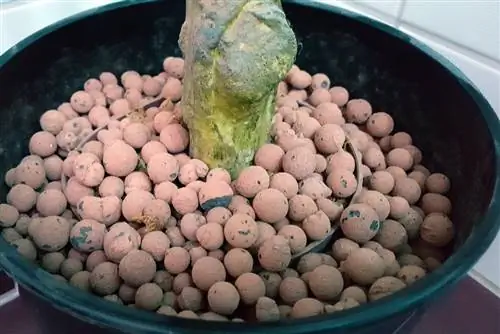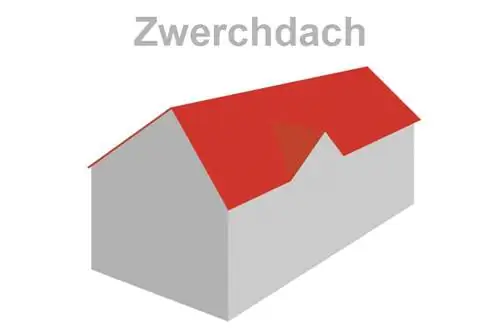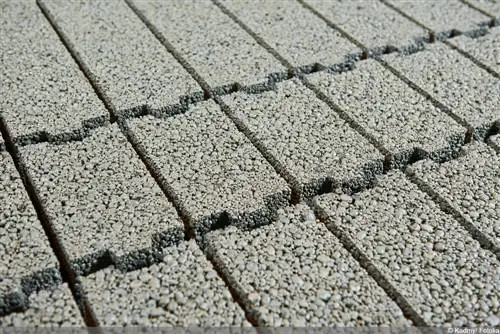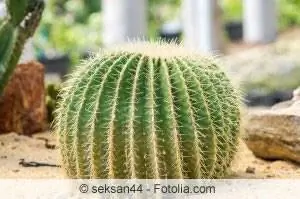- Author admin [email protected].
- Public 2023-12-17 03:39.
- Last modified 2025-06-01 06:48.
Plants are increasingly being planted in clay granules. The advantages of this substrate are obvious, because it is visually appealing, largely germ-free and easy to care for. Of course, the most important property of expanded clay is its ability to store water in large quantities. The granules slowly return moisture to the roots, protecting the plant from both drying out and excessive watering. The granules have few disadvantages, some aspects need to be taken into account when caring for them.
Why is clay granules a strong water reservoir?
To understand why expanded clay can store large amounts of water, it's worth taking a quick look at how clay granules are made. This material is produced in ovens at extremely high temperatures. At around 1000°C the surface of clay grains is sintered, i.e. made stronger. At the same time, gases escape from the interior of the grain - combustion products of organic components of the clay.
The gases do not destroy the surface, but rather form microscopically fine pores in it and expand the clay grains. The result is granules with a solid but porous surface - an ideal water reservoir. When watering, the pores fill with water, which can only escape slowly. Clay granules therefore create favorable conditions for successful plant cultivation.
Advantages of clay granules
It is no coincidence that expanded clay is so popular with hobby gardeners, as its advantages as a water reservoir are obvious. Here are the most important ones.
- Water storage in a class of its own. The expanded clay grains are lightweight; one grain can store up to 0.6 times its volume in water. The water is well secured in the clay granules and is only returned to the roots in smaller portions.
- Clay granules enable large intervals when watering and this is exactly where the greatest strength of this substrate lies. Even if you haven't watered for a few days, for example because of a vacation or business trip, it won't affect a plant.
- Waterlogging is no longer a danger. The most common mistake a hobby gardener makes is overwatering. Most plants don't like having “wet feet,” let alone swimming in water. If you regularly water too much or water “in reserve” before a longer absence, there is a risk of dangerous root rot. In the worst case, the roots die and with them the plant. Thanks to the clay granules, the risk of waterlogging is largely averted, because water that cannot be immediately absorbed by the roots is stored in the granules.
Tip:
Even clay granules do not provide 100% protection against waterlogging because, although their capacities are large, they are ultimately limited. You must therefore always pay attention to the water level indicator!
Germ and pest free. Clay granules are an inorganic substance and therefore contain no nutrients. This means that this substrate does not form a breeding ground for germs or pests. Mold also rarely develops on expanded clay. Clay granules are therefore he althy for the plant and usually look well-groomed and pleasant
Disadvantages and problems when dealing with clay granules
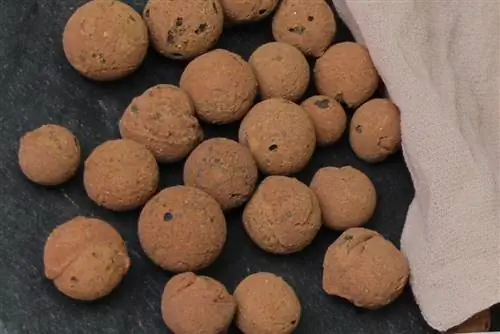
As already mentioned, this substrate has little disadvantage for plant culture, but if some aspects are not taken into account, a plant is in danger of dying.
Water level gauge is mandatory
Without this compact measuring device, it can never be said with certainty whether the plant needs water or still has enough. The granules usually look deceptively dry, especially on the surface. It can easily appear that the plant is thirsty. So always take a close look at the display before watering.
Tip:
Add water only when the display has really reached a minimum.
Easy is dangerous
The expanded clay is very light when dry. Soaked in water, it will of course be quite heavy. After all of the water has been largely used up by the plant, the granules become lightweight again.
The Problem
A large, heavy plant loses its support and can even tip over.
Tip 1
The larger the plant and the pot, the coarser the granules should be. Several varieties of this substrate are available commercially.
Tip 2
When filling the pot with granules, place some heavy stones on the bottom or mix the granules with sand. The heavy sand makes the substrate more stable, of course the plant should feel comfortable in sandy soil.
Don’t forget to fertilize
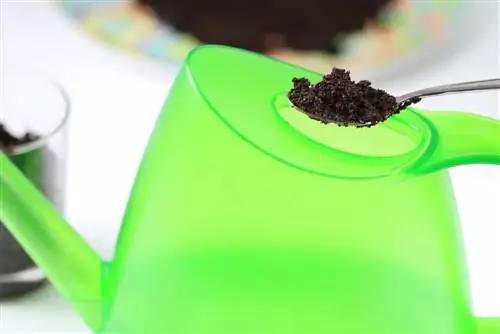
The granules are neutral, i.e. this substrate lacks the nutrients vital for a plant. Watering alone is certainly not enough for the plant to thrive, especially if it is supplied with tap water (never use water directly from the tap, leave it at room temperature for at least a few hours!) That's why adding fertilizer is vital. When choosing a fertilizer, make sure that it is also suitable for clay granules.
Tip:
Of course, the granules not only store the water, but also the liquid fertilizer. Therefore, there is a risk of over-fertilization - but for a plant, too much fertilizer is just as bad as no fertilizer at all. It is better to fertilize at slightly longer intervals than stated on the packaging.
FAQ
Can the water-retaining properties of conventional potting soil be improved using expanded clay?
Yes, clay granules can be mixed into the plant soil to loosen it up and ensure better drainage and store more water. By the way: A watering indicator (water level indicator) is also a good help here and shows whether there is a need for watering.
Do clay granules store less water over time?
Expanded clay is actually structurally stable and extremely durable. But every 3-4 years it is worth repotting a plant in fresh granules; the “old” substrate can be used again after being thoroughly cleaned with hot water (without detergent!) and air-dried.
Are there alternatives to clay granules as water storage?
Yes, recently the so-called geohumus has also been offered on the market as a water-storing substrate. This soil additive can absorb considerable amounts of liquid and largely improve soil function. In contrast to clay granules, geohumus loses its water-storing properties after a few years.

